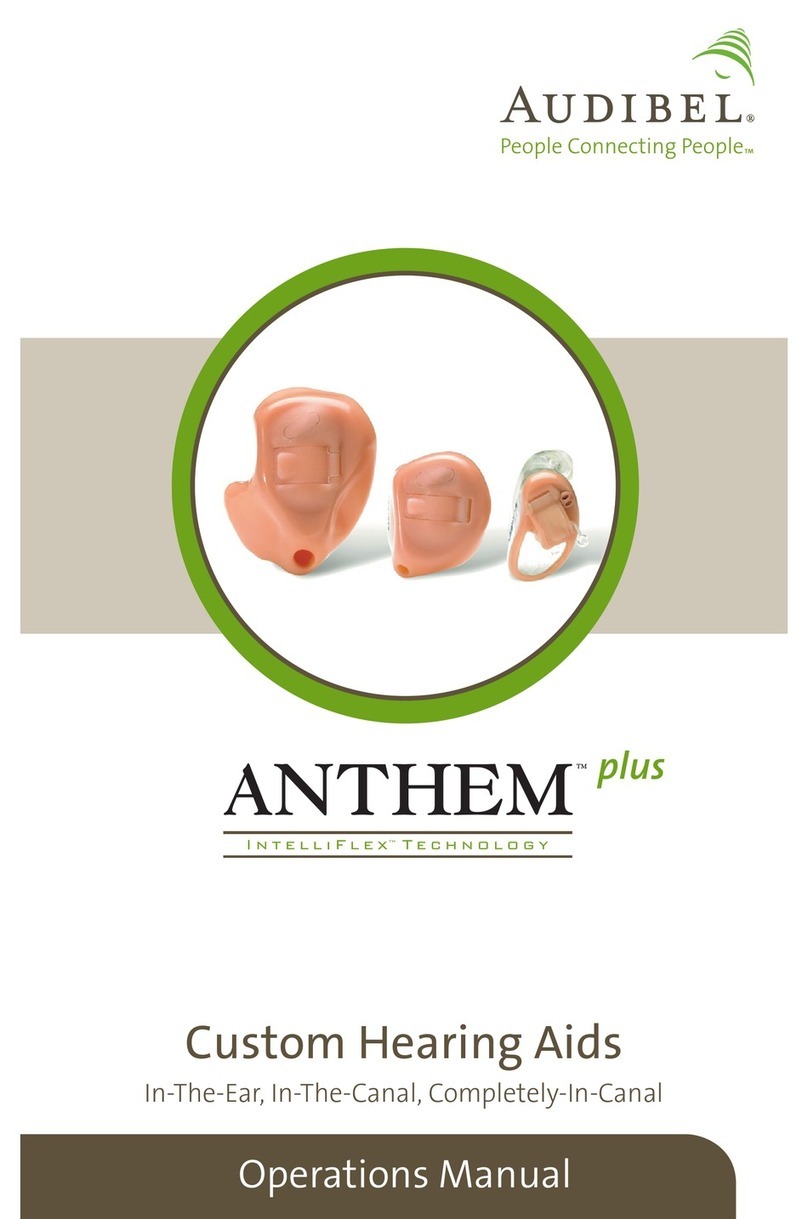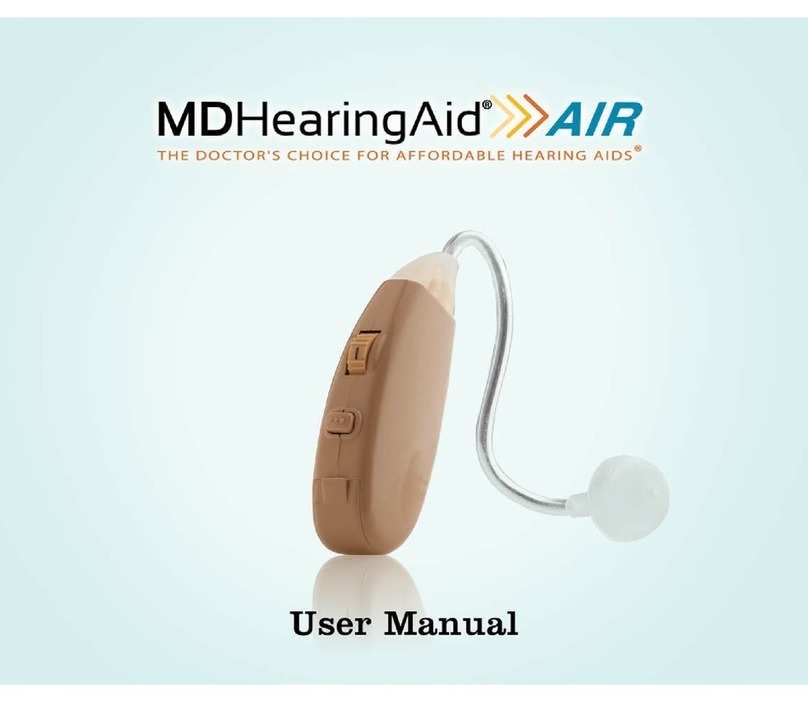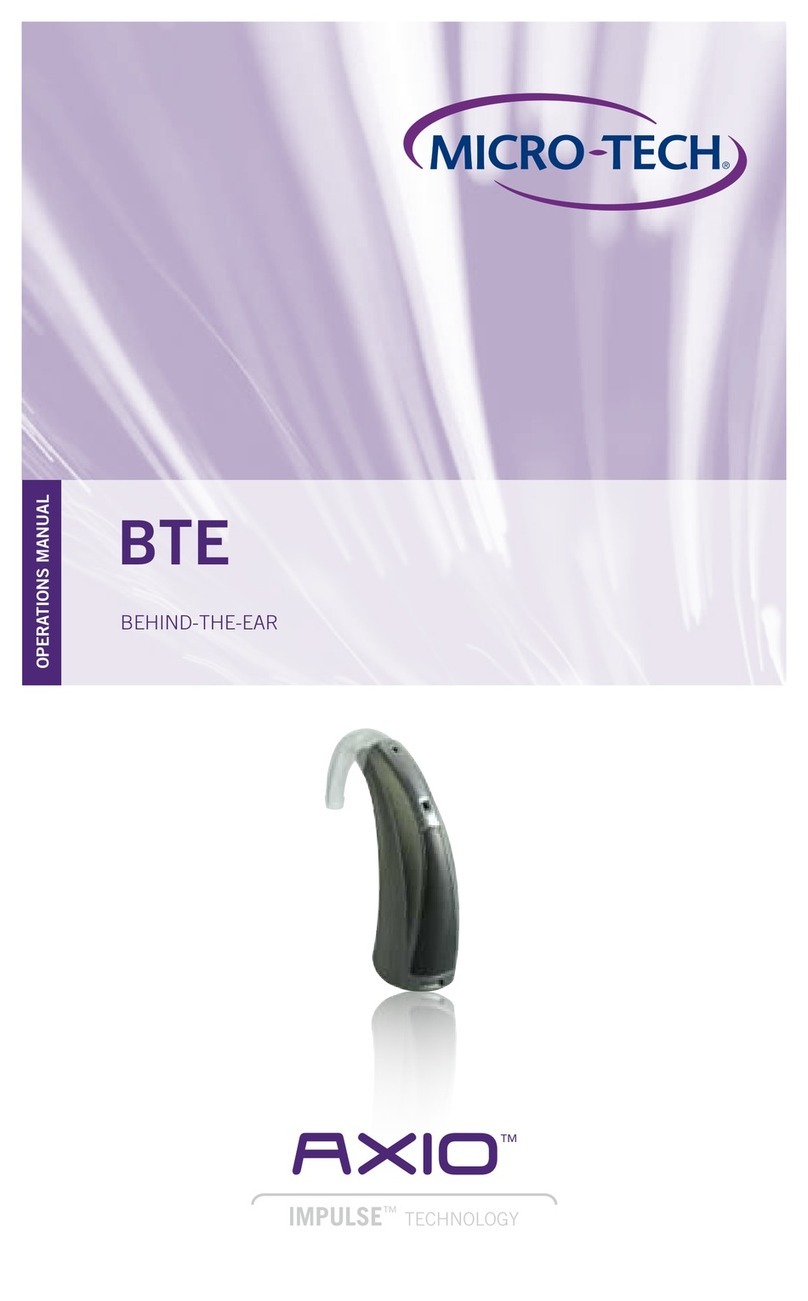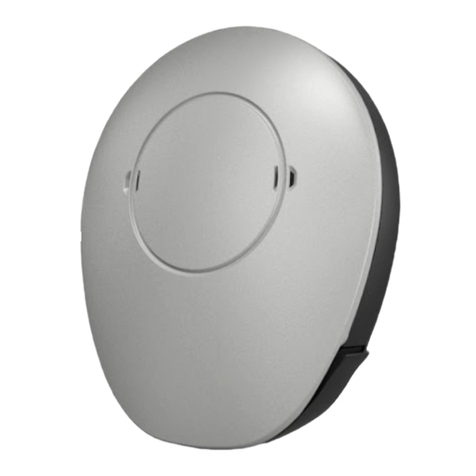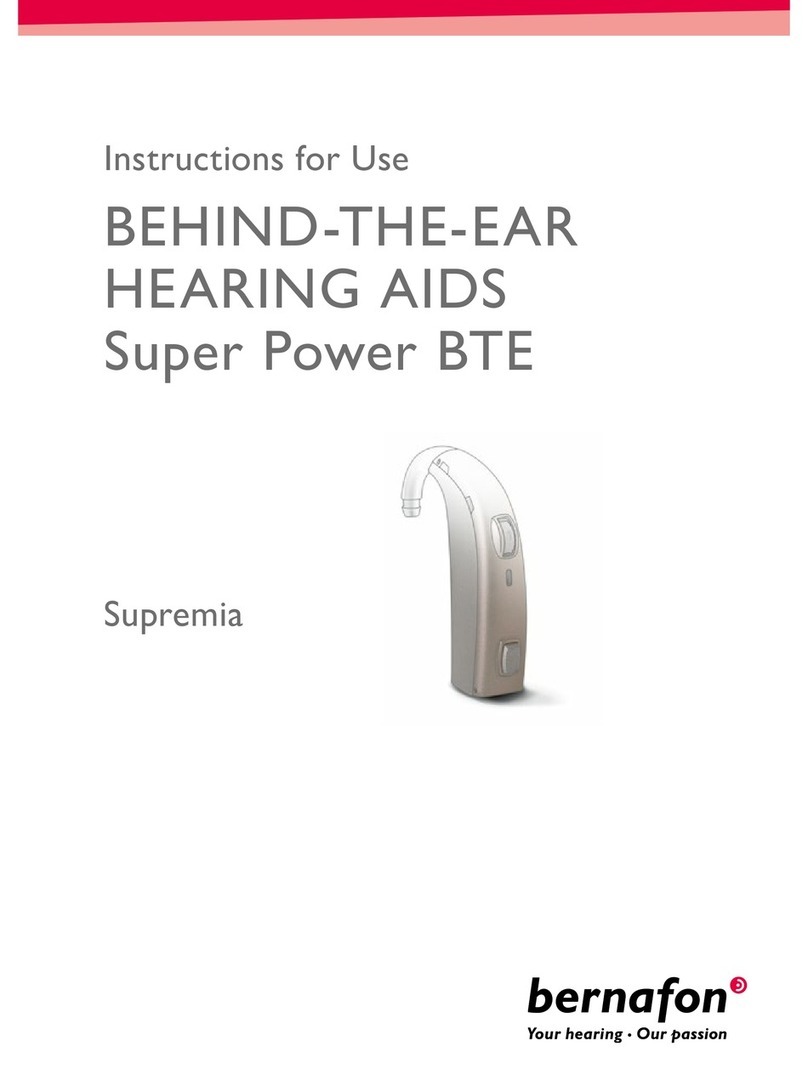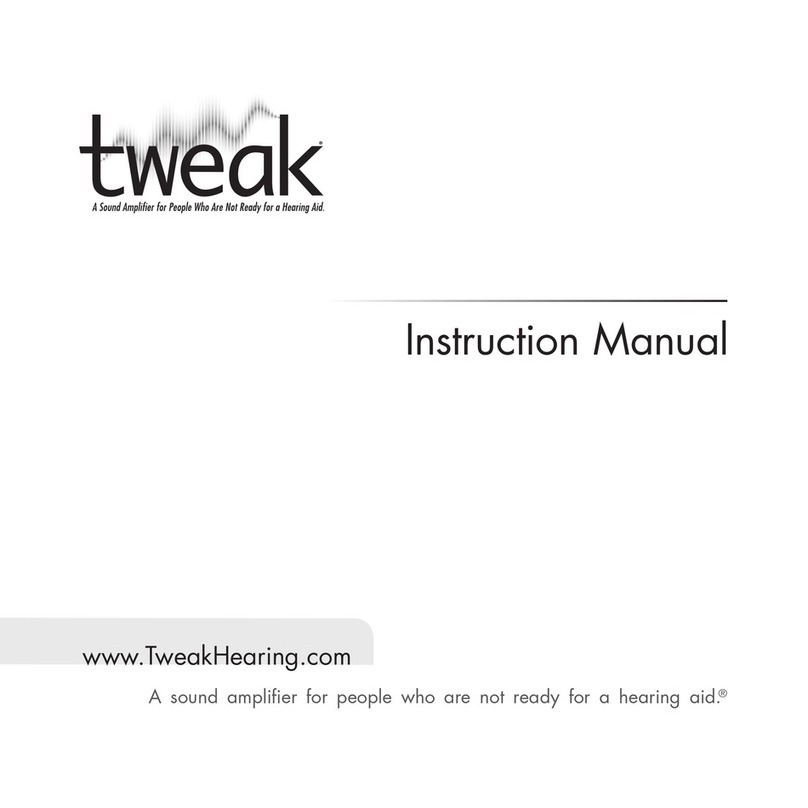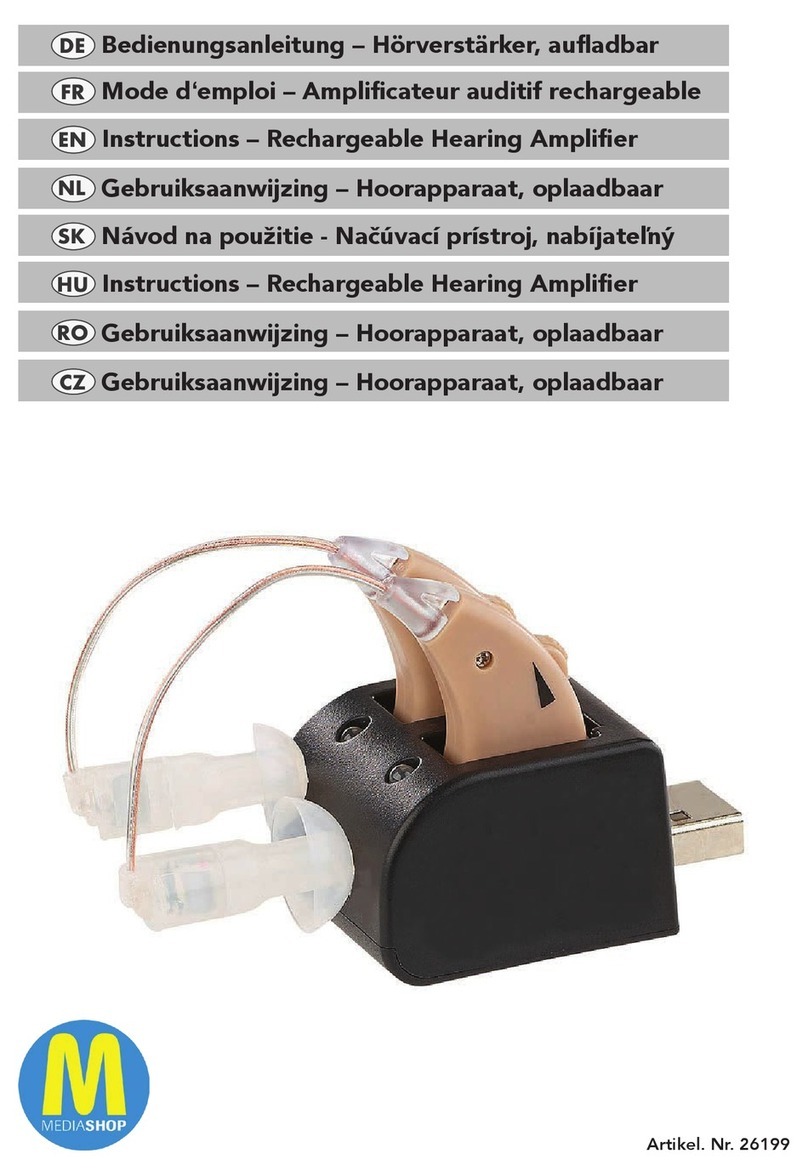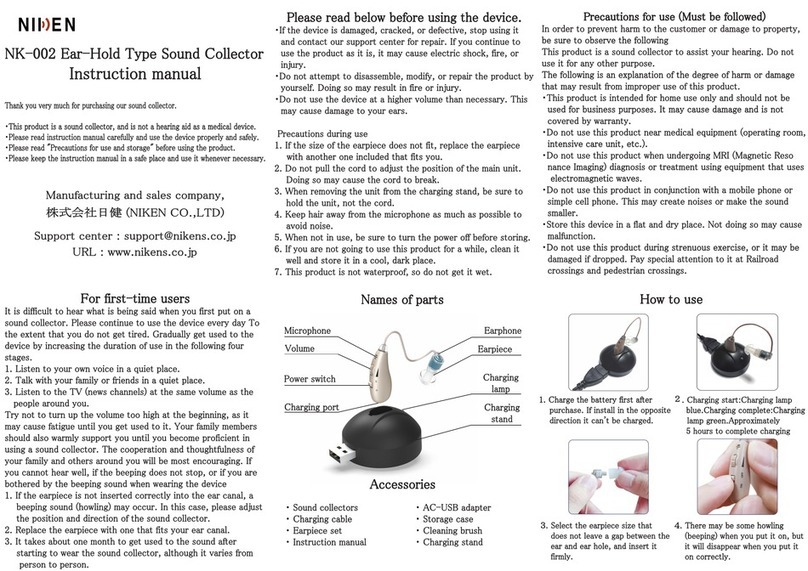Audibel invisibel anthem xt User manual

(Invisible-In-The-Canal)
operations manual
IIC

Table of Contents
Overview
IIC Overview ............................... 3
Preparation
Batteries................................... 4
Battery Indicators............................ 6
Insertion and Removal ........................ 8
Operation
On & Off .................................. 11
Volume Control ............................. 12
Multimemory ............................... 12
T2(touch-tone) Function ...................... 13
T2Troubleshooting Guide ..................... 14
Telephone Use .............................. 15
Hearing System Care
Instrument Care ............................. 17
Service and Repair ........................... 19
Troubleshooting Guide ....................... 19
Tips for Better Communication
For You.................................... 20
For Your Family and Friends ................... 21
FDA Information
Required Information......................... 22
Limited Warranty ............................ 24

3
2
Features, Controls and Identification
Your hearing system controls include:
1. Microphone opening
2. Sound outlet (receiver)
3. Battery compartment (on/off control)
4. Removal handle
5. Vent (optional)
Your hearing system can be identified by the
whiteR for the right ear and L for the left ear
and the serial number:
6. Location of serial number
IIC Overview
1
3
5
4
6

4
Preparation
Batteries
Your hearing system uses a battery as its power
source. This battery size can be identified by the
yellow (10) color code on the packaging.
To insert or replace the battery:
1. Use the nail grip on the battery door.
2. Open the battery door gently and remove
the old battery.
3. Remove the tab from the new battery.
4. Line up the battery’s “+” sign (flat side of the
battery) with the “+” on the battery door.
5. Close the battery door.

5
Preparation
1 2
3 4
5

6
Preparation
Battery Indicators
An indicator will sound when the battery voltage is
low. You have approximately 5 minutes* to replace
the battery. An indicator will sound just before the
battery stops working.
* Actual time between low battery indicator and
shut down will vary depending on environmental
noise levels and brand of battery used.
Helpful Hints
• NEVERFORCETHEBATTERYDOORSHUT;
thiscouldresultinseriousdamage;ifthedoorwill
not close securely, check that the battery is
inserted correctly.
• Donotopenthebatterydoortoofarordamageis
likely to occur.
• Becauseoftheirsize,it’sagoodideatochange
and replace batteries above a table or desk to
reduce the risk of dropping the instrument or
battery.
• Disposeofusedbatteriesimmediatelyinthe
proper waste or recycling container.
•
Because batteries can vary in size and
performance, your hearing care professional is your
best source for lifespan estimates and verification
that you are using the proper size and type.

7
Warnings
Batteries are dangerous if swallowed. To help
prevent the accidental ingestion of batteries:
Keep out of reach of children and pets
Check your medications before taking them –
batteries have been mistaken for pills
Neverputbatteriesinyourmouth,astheycan
easily be swallowed
National Button Battery Ingestion Hotline:
202-625-3333
Preparation

8
Preparation
Insertion and Removal
It is very important that you work closely with your
hearing professional to develop an insertion
technique that is specific for the shape and
contours of your ear. Improper insertion will
result in unsatisfactory performance and comfort.
To insert the hearing instrument:
1)DetermineLeftorRightbylocatingtheside
marker on the hearing instrument.
2)Holdtheinstrumentinthesamesidehandwith
the dot marker on top.
3) Lift the device to the ear and place at the opening
of the ear canal.
4) Push the device into place in the ear, using the
end of the removal cord as indication that the
device is inserted all the way.

9
Preparation
To remove the hearing instrument:
Grasp the removal handle found at the bottom
of the ear canal and gently remove the hearing
instrument from the ear.

10
Preparation
Helpful Hints
• Itisnotunusualforthehearingaidtofeelquite
foreign in the ear canal initially, but very natural
over time as your ear adapts. It may be necessary
to adopt a wearing schedule that gradually
increases the time that you wear your hearing aids.
Work with your hearing professional to develop a
wearing schedule appropriate for your needs.
•
Minor irritation and inflammation may occur as your
earbecomesaccustomedtohavinganobjectinit;
if so, please contact your hearing care professional.
• Ifanactualallergi
c reaction occurs, alternative
materialsareavailable;contactyourhearing
care professional.
• Severeswelling,dischargefromtheear,excessive
wax, or other unusual conditions warrant
immediate consultation with a physician.
• Ifdesired,applyasmallamountofOto-Easetothe
outside of the hearing instrument being careful to
not get any in the receiver/sound opening.
• Itmaybehelpfultolifttheexternalearwithyour
opposite hand to straighten the ear canal during
insertion. You will know the hearing instrument is
in position when it sits firmly and comfortably in
the ear.
• Verifyproperinsertionvisuallywithastationary
hand mirror reflecting the opening of the ear
canal, and finally adjust the position of the removal
handle as directed by your hearing professional.

11
Operation
Insert a battery and
completely close the
battery door.
To turn OFF:
Open the battery door until the battery is no longer
touching the battery contacts.
Your instrument has a Power-On delay and may
require a few seconds to power on. You may hear
a tone series indicating that your device is fully
powered on.
On & Off
To turn ON:

12
Operation
Volume Control
Automatic Volume Control
Your hearing system has been set to a specific
volume level by your hearing care professional.
If sounds are generally too loud or too soft, please
contact your hearing care professional for advice
and adjustment.
Multimemory
Your hearing care professional can set up to four
hearing programs for you. These additional programs
are accessed using T2. See page 13 for more
information on T2functionality.
When you press the appropriate button on your phone,
you may hear an indicator or a tone series indicating
the device has changed to the next program.
Ask your hearing professional about your specific
hearing programs.
My hearing instrument uses T2for Multimemory
control. Please read the section below.
My hearing instrument does not have
Multimemory. See page 13.
My hearing instrument volume is set automatically.
Please read the section below.
My hearing instrument uses T2for volume control.
See page 13.

13
Operation
T2(touch-tone) Function
You may use a cell phone, cordless telephone, or
corded telephone to adjust your hearing system. The
telephone MUST “beep” when the keys are pressed
for this function to work. If your telephone does not
“beep” when the keys are pressed, consult your
telephone operator’s manual or contact your
telephone service provider.
•
Holdthephoneapproximately3inchesfromtheear
•
Press ** to “wake” T² (a tone series indicates that it
is ready for a command)
•
Press the telephone key that corresponds to the
desired function
•
T² will “sleep” after 20 seconds
Use the following keypad buttons to
remotely adjust your hearing aid settings.
My hearing instrument has T2capability.
Please read the section below.
My hearing instrument does not have T2capability.
See page 14.
Volume
Memory Memory
Press 2 times
to wake
Mute
Volume

14
Operation
SYMPTOM POSSIBLE CAUSES SOLUTIONS
Hearingsystem
not responding
to telephone
command
Telephone keys not
emitting beep tones
Consult telephone
operator’s manual to
enable beep tones
T² not unlocked prior
to command Press ** and listen for
unique T² indicator
Telephone too far
from hearing system
Bring telephone closer
to hearing system
microphone
Incorrect key command
Press ** to wake then
press 2 or 8 to increase
or decrease volume or
4 or 6 to change programs
if device has multiple
programs
Hearingsystem
responded but
won’t respond to
later command
T² automatically
“sleeps” 20 seconds
after last command
Press ** to wake then
press key that corresponds
to desired action
T2 Troubleshooting Guide

15
Telephone Use
Bring the telephone
receiver up to your ear
as you would typically
hold it without a hearing
device in the ear.
General Telephone Use
Some hearing instruments
work best by holding the
phone close to, but not fully
covering your ear. In some
instances, if you encounter
whistling (feedback), tilt the
receiver at an angle until the
whistling stops. Your hearing
professional can provide
instructions and techniques
for your specific needs.
Operation

16
Operation
DISCLAIMER – Some hearing aid users have reported a
buzzing sound in their hearing aids when they are using
cell phones, indicating that the cell phone and hearing
aid may not be compatible. According to the ANSI
C63.19 standard (ANSI C63.19-2006 American National
Standard Methods of Measurement of Compatibility
Between Wireless Communications Devices and
Hearing Aids), the compatibility of a particular hearing
aid and cell phone can be predicted by adding the
rating for the hearing aid immunity to the rating for
the cell phone emissions. For example, the sum of a
hearing aid rating of 2 (M2/T2) and a telephone rating
of 3 (M3/T3) would result in a combined rating of 5.
Any combined rating that equals at least 5 would
provide “normal use”; a combined rating of 6 or
greater would indicate “excellent performance.”
The immunity of this hearing aid is at least M2/T2. The
equipment performance measurements, categories
and system classifications are based upon the best
information available but cannot guarantee that all
users will be satisfied.
NOTE: The performance of individual hearing aids
may vary with individual cell phones. Therefore, please
try this hearing aid with your cell phone or, if you are
purchasing a new phone, be sure to try it with your
hearing aid prior to purchase. For additional guidance,
please ask your cell phone provider for the booklet
entitled “Hearing Aid Compatibility with Digital
Wireless Cell Phones.”

17
Hearing System Care
Instrument Care
Because of the variability of individual ear canal
physiology, maintenance needs vary. Work
with your hearing professional to develop a
maintenance routine best for you.
General maintenance guidelines:
a. Inspect your hearing aid with good light and
a magnifying glass if necessary, and become
familiar with the look of a properly maintained
hearing aid.
b. Wiping the exterior of the hearing aid off with
a soft cloth or tissue in the morning before
wearing is typically the best routine.
c. Inspect the microphone and receiver ports
every morning and brush away any wax or
debris.
d.Dependingontheconditionsofyourear,a
desiccating kit or appliance may be necessary
to ensure reliable performance. Please check
with your hearing professional.
Your hearing care professional can provide further
information on additional maintenance procedures
for your hearing system if needed.

18
Hearing System Care
Helpful Hints
• Whennotwearingyourhearinginstruments,
open the battery door to allow any moisture to
evaporate
• Whennotinuse,removethebatteries
completely;placeyourhearingsysteminthe
storage container and store:
– In a dry, safe place
– Away from direct sunlight or heat to avoid
extreme temperatures
– Where you can easily find them
– Safely out of reach of pets and children
• Donottakeapartyourhearinginstrumentsor
insert the cleaning tools inside them

19
Hearing System Care
Service and Repair
If, for any reason, your hearing system does not operate
properly,doNOTattempttoxityourself.Notonly
are you likely to violate any applicable warranties or
insurance, you could easily cause further damage.
Should your hearing system fail or perform poorly,
check the guide below for possible solutions. If
problems continue, contact your hearing care
professional for advice and assistance.
Troubleshooting Guide
SYMPTOM POSSIBLE CAUSES SOLUTIONS
NotLoudEnough
Low battery Replace battery
Wax or debris in
the microphone or
receiver
Clean both microphone
and receiver with brush
Hearingchange Contact your hearing
care professional
Inconsistent
Performance
Low battery Replace battery
Unclear,Distorted
Performance
Low battery Replace battery
Defectivehearing
instrument
Contact your hearing
care professional
Dead
Low battery Replace battery
Wax or debris in
the microphone or
receiver
Clean both microphone
and receiver with
brush.

20
Tips for Better Communication
Your hearing care professional will recommend an
appropriate schedule to help you adapt to your
new hearing system. It will take practice, time and
patience for your brain to adapt to the new sounds
thatyourhearingsystemprovides.Hearingisonly
part of how we share thoughts, ideas and feelings.
Reading lips, facial expressions and gestures
can help the learning process and add to what
amplification alone may miss.
Please review the following simple
communication tips:
For You
•Moveclosertoandlookatthespeaker
• Sitface-to-faceinaquietroom
• Trydifferentlocationstondthebestplace
to listen
• Minimizedistractions
• Backgroundnoisesmaybefrustratingatrst;
remember, you have not heard them for a while
• Letothersknowwhatyouneed;keepinmind
that people cannot “see” your hearing loss
• Developrealisticexpectationsofwhatyour
hearing instruments can and cannot do
• Betterhearingwithhearinginstruments
is a learned skill combining desire, practice
and patience
Table of contents
Other Audibel Hearing Aid manuals

Audibel
Audibel BTE User manual
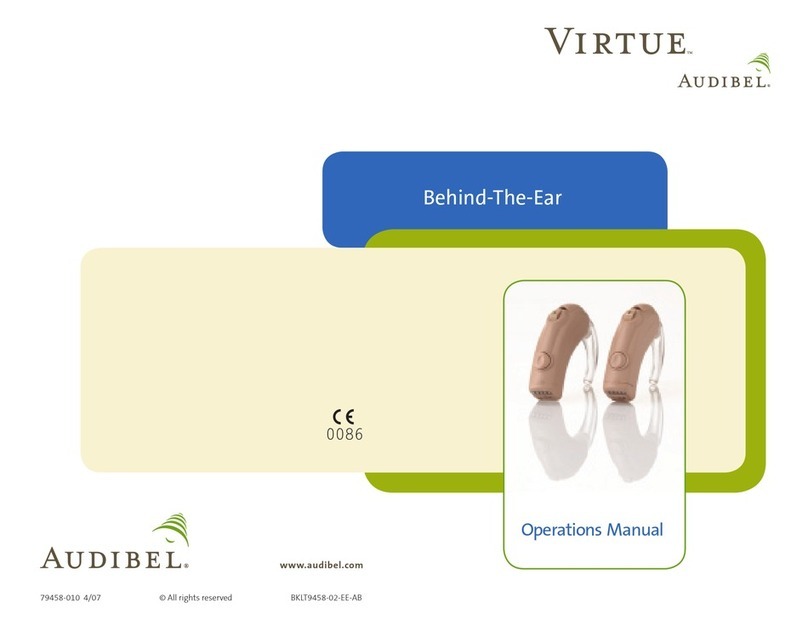
Audibel
Audibel Virtue User manual

Audibel
Audibel LX User manual
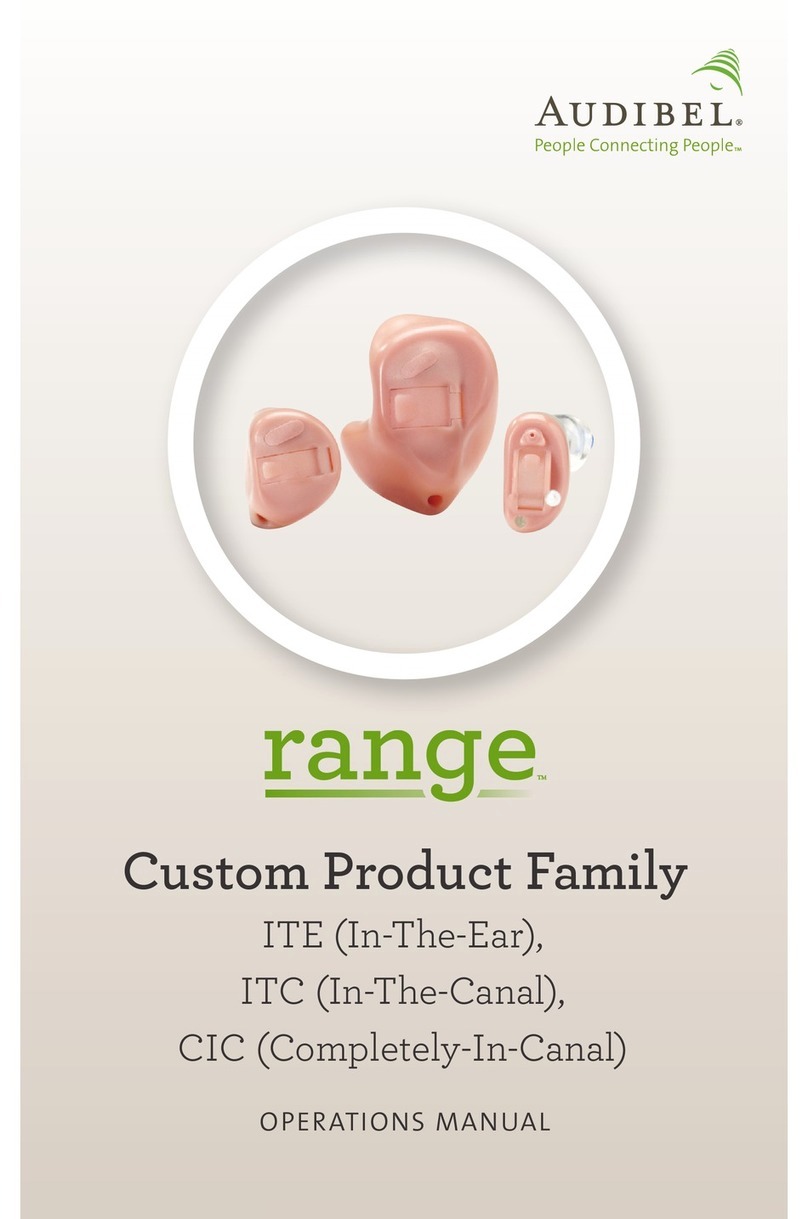
Audibel
Audibel range ITE User manual
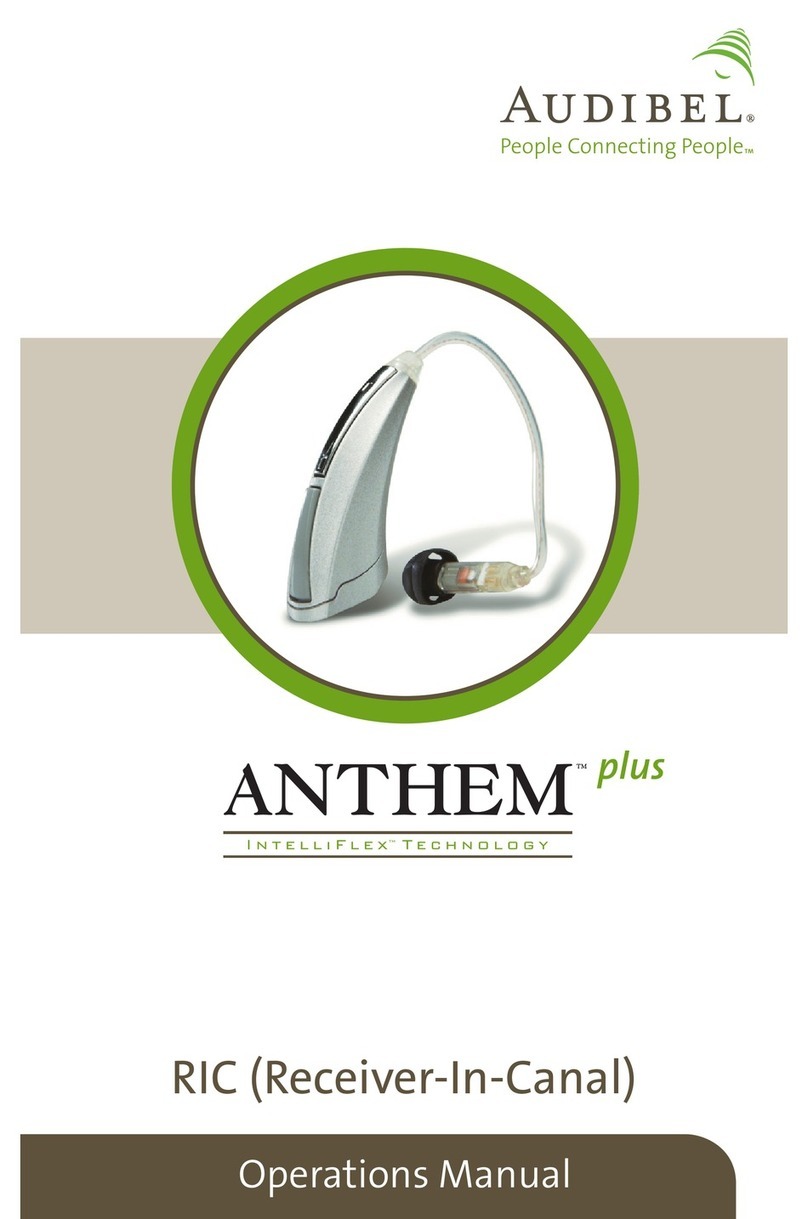
Audibel
Audibel Anthem Plus User manual

Audibel
Audibel A4 iQ R User manual
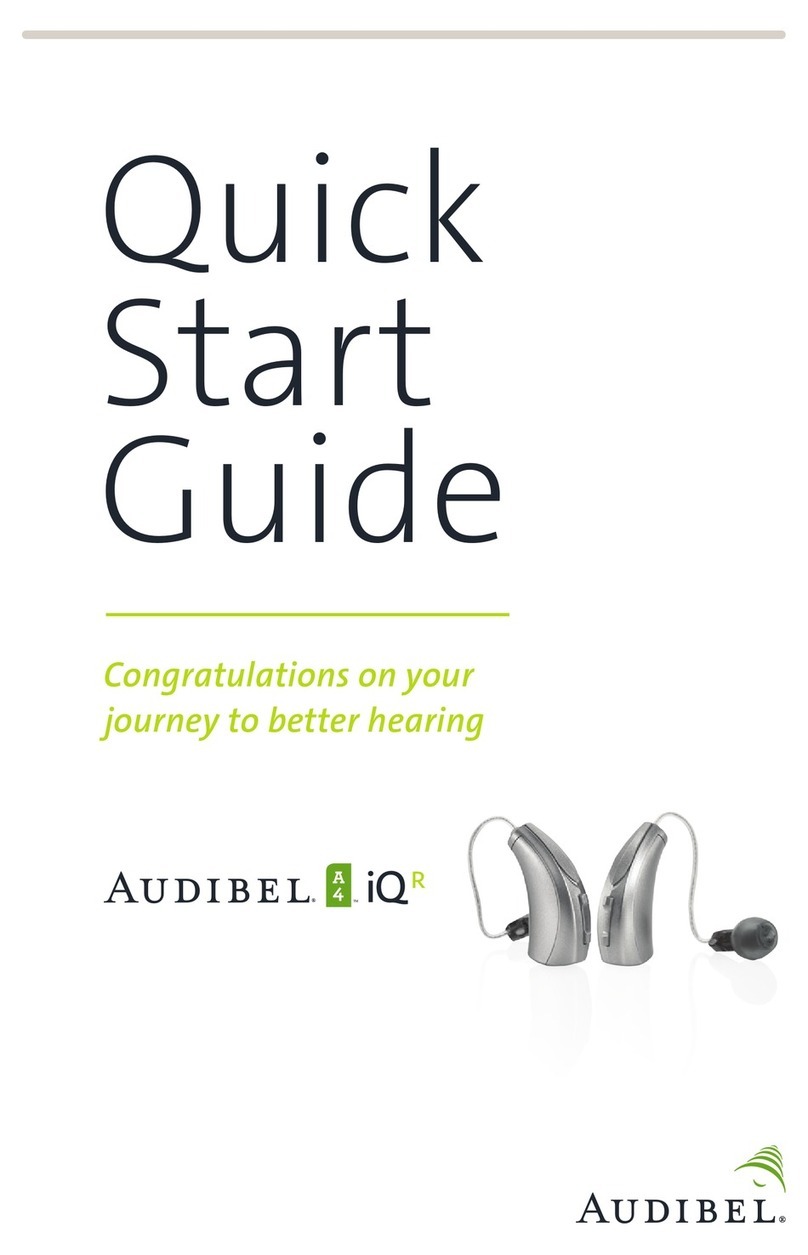
Audibel
Audibel A4 iQ R User manual
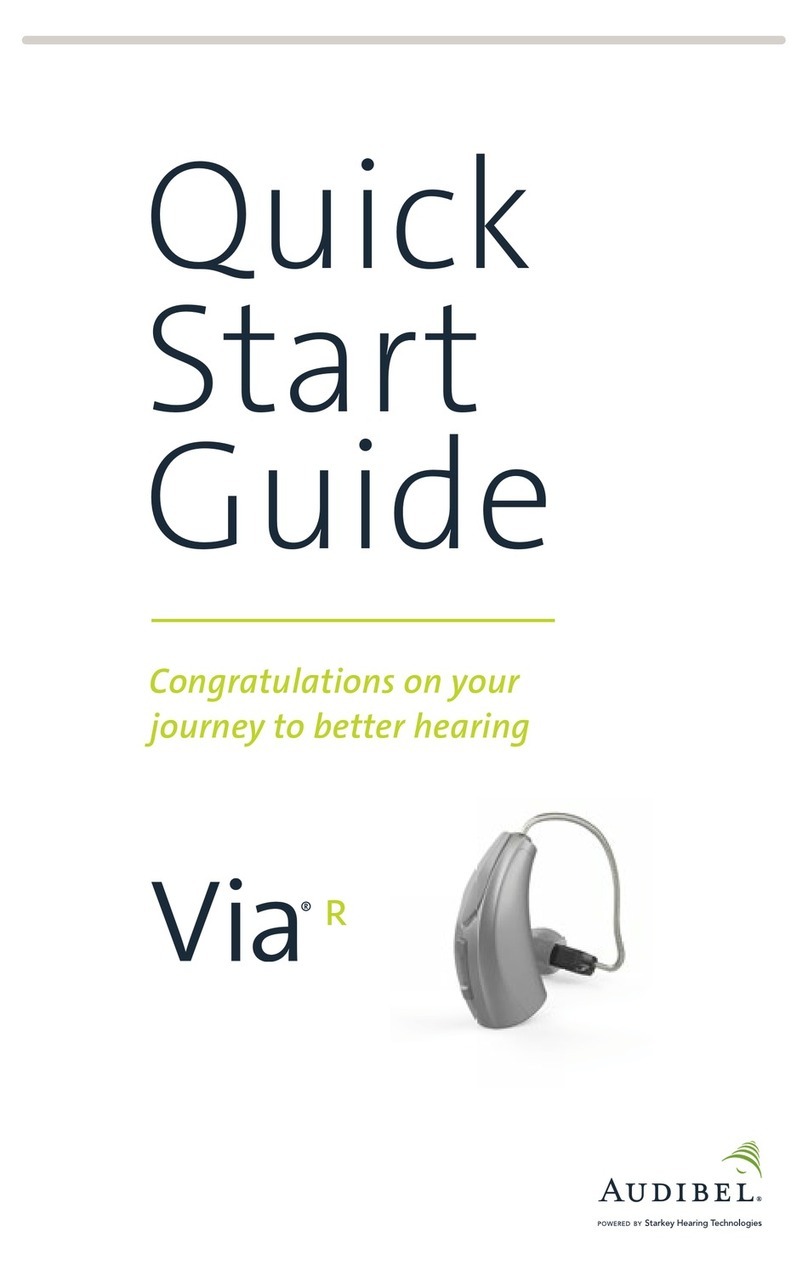
Audibel
Audibel Via Rechargeable User manual
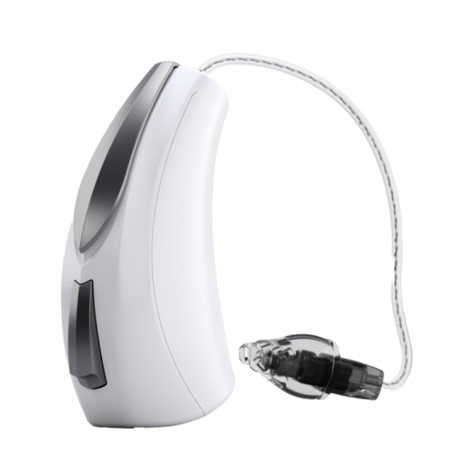
Audibel
Audibel Arc AI User manual

Audibel
Audibel Anthem User manual
